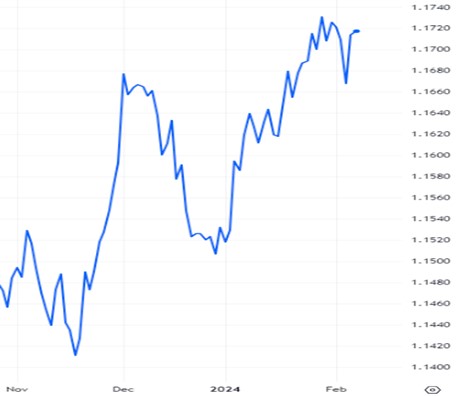GBP-EUR Exchange Rate Hits Six-Month High in January
The GBP-EUR exchange rate stumbled into 2024, briefly dipping below 1.15 after the UK’s latest manufacturing PMI printed below expectations, in contrast to the Eurozone’s factory sector which exceeded forecasts – but remained in contraction.
The pair gained traction on 3 January as unemployment increased in Germany – the bloc’s largest economy.
The pound was muted over the following two days, despite the latest UK services PMI printing above expectations and a surprise rise in Eurozone inflation, which ticked up for the first time since April 2023 – leaving the UK currency a fraction below the 1.16 benchmark.
Having touched a two-week high, the pound retreated against the euro on 8 January following the publication of a better-than-expected German trade report and an upbeat economic sentiment indicator for the bloc – data that dovetailed with the hotter-than-expected inflation print to dampen ECB rate cut expectations.
The GBP-EUR exchange rate traversed the 1.16 range for a prolonged period, remaining subdued despite a rebound in UK growth. Investors in the pound shrugged off stronger-than-expected UK GDP figures on 12 January, as fears persisted that the economy slipped into a recession at the end of 2023.
The pound was given an injection of strength on 17 January by warming inflation. The latest UK CPI reading unexpectedly rose from a two-year low to 4%, beating economists’ forecasts that it would cool to 3.8%. Expectations of monetary policy loosening were quelled by the print, causing the GBP-EUR exchange rate to surge to a monthly high in the 1.16 mid-range.
After retreating amid lack of data, the pound was buffeted by persistent recessionary headwinds as shrinking UK retail sales reinforced economic concerns. The depth of its decline was mitigated by rapidly cooling German factory inflation.
The GBP-EUR pair traded sideways again until upbeat UK PMIs lifted it above 1.17 on 24 January – a four-month high. The vital services PMI increased at its sharpest rate in eight months, boosting pound sentiment amid renewed signs of UK economic expansion.
The pound edged higher after the European Central Bank elected to leave interest rates unchanged – a decision that weighed on the euro. The single currency’s woes were compounded by investor speculation that weak economic performance in the Eurozone spells a loosening of restrictive monetary policy measures.
Soaring ECB rate cut bets propelled the GBP-EUR exchange rate to a six-month high in the 1.17 mid-range on 29 January – capping a month that saw the pair chart a steady upward course.
GBPEUR: 3-Month Chart

Looking ahead
UK interest rates could be cut from their highest level in 16 years as soon as February, economists at Goldman Sachs said in November, while the BoE warned borrowing costs would remain higher for longer. The central bank will announce its latest decision on 1 February amid signs that the inflation crisis is subsiding.
Influential data from the UK economy in February: ILO Unemployment Rate (13 February), Consumer Price Index (14 February), Gross Domestic Product (15 February), Retail Sales (16 February), S&P Global/CIPS Services PMI (22 February).
Having left interest rates unchanged at its January meeting, following its hike to a record high in September, the ECB flagged significant positive progress on inflation but gave no indication it has started talking about rate cuts at its next meeting in March.






